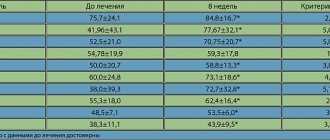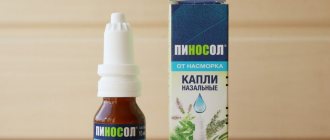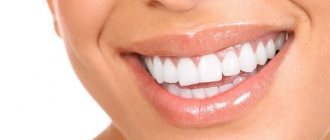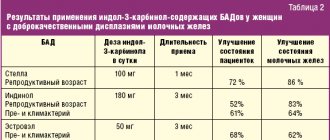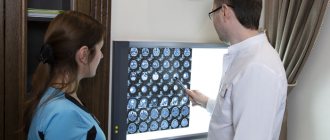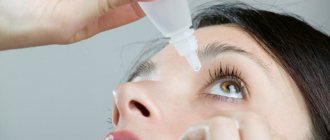Pharmacodynamics and pharmacokinetics
The main component of the drug, hexetidine , is an antiviral, fungicidal and antibacterial agent. It also has a slight anesthetic and enveloping effect. Hexetidine replaces thiamine , which promotes the growth of bacterial flora, which determines the antibacterial effect of the drug. In addition, this active component prevents the synthesis of substances that create the protective shell of fungi.
Methyl salicylate reduces the effect of the enzyme cyclooxygenase , stimulating blood to diseased areas and accelerating their recovery, as well as providing a local irritant and anti-inflammatory effect on the mucous membranes.
The combination of essential oils of the drug has a mild antibacterial and anti-inflammatory effect, and also reduces the feeling of discomfort when coughing.
The effect of the medicine lasts about 11 hours. All components are excreted with saliva . They do not enter the general bloodstream and are evenly distributed on the mucous membrane of the pharynx and mouth.
Compound
| Solution for topical use | 100 ml |
| active substance: | |
| hexethidine | 0.1 g |
| excipients: methyl salicylate; peppermint essential oil; carnation flowers oil; anise essential oil; eucalyptus essential oil; sassafras essential oil; levomenthol; sodium saccharinate monohydrate; citric acid monohydrate; crimson dye (Ponceau R); polysorbate 60; ethanol 96%; purified water |
| Topical spray | 1 fl. |
| active substance: | |
| hexethidine | 0.0577 g |
| excipients: methyl salicylate; anise essential oil; eucalyptus essential oil; orange flower essential oil; sassafras essential oil; peppermint essential oil; levomenthol; sodium saccharinate monohydrate; glycerol 85%; ethanol 96% |
Indications for use
The medicine is used for:
- the need to eliminate unpleasant odor in the oral cavity ;
- infectious and inflammatory diseases, fungal diseases and injuries occurring in the larynx and oral cavity;
- prevention of infection of the alveoli after tooth extraction ;
- prevention of superinfection in destructive tumors of the larynx and oral cavity.
Experience with the use of the drug stopangin in the treatment of inflammatory diseases of the pharynx in children
Chronic tonsillitis, which is a long-term inflammatory process in the palatine tonsils, is one of the most pressing problems in pediatric otorhinolaryngology. This is due to the extremely important role of the tonsils in the formation of mechanisms of specific and nonspecific defense of the child’s body during its growth. Chronic tonsillitis accounts for 4 to 9% of all diseases in children [1]. In the group of frequently ill children, chronic tonsillitis accounts for 43% [2]. The disease is manifested by frequent sore throats in combination with general toxic-allergic phenomena: periodic rise in temperature, tonsillogenic intoxication, accompanied by weakness, as well as periodic pain in the joints and heart. Among the complications of chronic tonsillitis, it is necessary to highlight lateral and retropharyngeal abscesses, as well as rheumatism, diseases of the urinary system, prostate gland, and meninges [3]. Thus, chronic tonsillitis must be considered as a focal infection, the elimination of which is an extremely important part of the task of maintaining the health of the child as a whole, as well as preventing diseases associated with chronic tonsillitis [4].
Due to the empirical nature of prescribing antibacterial therapy and the widespread prevalence of resistant strains of the main pathogens, recently increasing importance has been given to the inclusion of locally active drugs in the treatment regimen. One of the promising areas is the prescription of drugs that combine antiseptic, anti-inflammatory and analgesic effects. The Ivex drug Stopangin meets these requirements.
Stopangin is a combination drug that contains three main components: hexetidine, methyl salicylate and a complex of essential oils. The main active ingredient, hexetidine, has a wide range of pharmacological properties. Hexetidine has a bactericidal and bacteriostatic effect, and has an antifungal and antiviral effect. The drug is active against S. aureus, S.pyogenes, S.epidermidis, Clostridium perfringens, Mycobacterium tuberculosis, Escherichia coli, Klebsiella pneumoniae, Proteus vulgaris, Candida spp., Actinomyces spp., Trichophyton spp., Histoplasma capsulatum, etc. [5] . It is reported that strains with acquired resistance to antibiotics do not develop cross-resistance to hexetidine, even with prolonged treatment with this drug for 5 months. In addition to its antimicrobial properties, hexetidine has a hemostatic and analgesic effect, which justifies its use after tonsillectomy [5]. Unlike chlorhexidine, it is low-toxic and can therefore be prescribed to children. Methyl salicylate has analgesic and anti-inflammatory effects. Stopangin is available in the form of a spray and a solution for gargling. stopangin contains a complex of essential oils: anise, eucalyptus, sassafras, clove, peppermint oil. They have not only softening, but also antiseptic effects.
In the Department of Ear, Nose and Throat Diseases of the Federal State Institution MNIIPiDH Roszdrav, a study was conducted on the effectiveness of the drug stopangin in the treatment of chronic compensated tonsillitis (CCT) and chronic decompensated tonsillitis (CDT) in children in comparison with traditional therapy. During the study, the following tasks were solved: assessment of the anti-inflammatory and analgesic properties of the drug, both in the conservative treatment of chronic tonsillitis and after tonsillectomy, as well as the effect of stopangin on the pathogenic microflora of the pharynx before and after treatment.
The study involved 51 patients aged 5 to 17 years: 31 of them with CCT and 20 patients with CDT after tonsillectomy. All children underwent a course of antibacterial therapy before hospitalization, some twice. The patient examination plan included a daily examination with an assessment of the dynamics of the condition of the pharyngeal mucosa and taking into account the patient’s subjective assessment of the severity of the pain syndrome on a visual analogue scale. All patients had their pharyngeal microflora examined before and after treatment.
All patients were divided into two groups (Table). Patients of the main group received treatment with Stopangin: the lacunae of the tonsils were washed with a solution of the drug 2 times a day (in patients after tonsillectomy, the oropharynx was rinsed), as well as the pharynx was irrigated with Stopangin spray 3 times a day. Patients in the control group received traditional therapy: washing the lacunae of the tonsils, rinsing the oropharynx with a solution of furatsilin or saline with the addition of eucalyptus tincture (1:10) and lubricating the pharynx with Lugol's solution. Children with HDT after tonsillectomy additionally had their throats irrigated with Cameton aerosol 3 times a day. The course of treatment was 7–8 days.
All patients initially complained of sore and dry throat and pain when swallowing. 50% of children had symptoms of intoxication: weakness, fatigue, increased sweating, periodic rise in temperature to low-grade levels, “flying” pain in the joints. Pharyngoscopy revealed in most children severe hyperemia of the anterior palatine arches and hypertrophy of the tonsils from grades I to III, usually with purulent plugs in the lacunae. With pharyngitis, the clinical picture was complemented by thickening of the lateral ridges of the pharynx or the presence of lymphoid granules on the posterior wall of the pharynx. With tonsillomycosis, there was a characteristic white coating on the surface of the tonsils.
All patients underwent a study of the pharyngeal microflora before starting treatment. In the first group, monoflora was sown in 4 patients; in the remaining 17, microorganisms were sown in association. In the second group, a monoculture was sown in 1 patient and an association of microorganisms was sown in 10 patients.
The study demonstrated a higher therapeutic effectiveness of the drug Stopangin compared to traditional therapy. In patients with CCT who received stopangin, by the 2–3rd day of treatment, the disappearance of pain and discomfort in the throat was noted; on the 3–4th day, hyperemia of the pharynx mucosa disappeared and the lymphoid tissue of the tonsils was significantly reduced. A decrease or disappearance of plaque on the tonsils with tonsillomycosis was observed on days 5–6. In the control group of children with CCT, the above symptoms resolved 2–3 days later.
In children with HDT (after tonsillectomy) with the use of stopangin, the pain syndrome resolved on the 3rd–4th day, by which time the hyperemia of the mucous membrane and swelling of the arches and uvula of the soft palate also disappeared. On the 4th–5th day, the almond niches were cleared of plaque. None of the patients in this group had trismus of the masticatory muscles or tenderness of the submandibular lymph nodes. In the control group, after tonsillectomy, pain when swallowing persisted until the 5th–7th day; the tonsil niches were cleared of plaque by the 7th–9th day. In 4 out of 10 patients, trismus of the masticatory muscles and the phenomenon of submandibular lymphadenitis of varying severity were noted.
Analysis of the microbial flora after treatment revealed the antibacterial effect of stopangin: in 70% of patients after a course of treatment with the drug, normal flora was noted in throat smears, while in the group receiving traditional therapy, pathogenic bacteria were not detected in 55% of patients.
No side effects were identified in the stopangin treatment group. Most children noted the pleasant taste of the drug.
The results of the study indicate the beneficial complex effect of the drug stopangin on children with chronic tonsillitis and after tonsillectomy.
- The use of the drug stopangin in children with chronic tonsillitis leads to a reduction in treatment time compared to traditional therapy due to the antiseptic and anti-inflammatory properties of the drug.
- The antimicrobial and antimycotic properties of the drug lead to faster disappearance of plaque and more effective sanitation of the oropharyngeal mucosa compared to traditional therapy.
- The use of stopangin can reduce the severity of pain in patients with chronic tonsillitis and children after tonsillectomy.
Literature
- Garashchenko T. I., Bogomilsky M. R., Shishmareva E. V. New approaches to the treatment of exacerbations of chronic tonsillitis in children // Children's infections. 2004. No. 1.
- Ponomarev L. E. et al. The influence of chronic tonsillitis on the formation of a group of frequently ill children from preschool institutions // News of otorhinolaryngology and logopathology. 1995. No. 3 (4).
- Palchun V. T., Kryukov A. I. Otorhinolaryngology. M.: Litera, 1997.
- Polyakova T. S., Polyakova E. P. Chronic tonsillitis: diagnosis, treatment, prevention // Breast cancer. 2004. T. 12. No. 2.
- Lopatin A.S. //RMJ. 2000. T. 2. No. 2.
N. V. Ziborova , Candidate of Medical Sciences S. A. Loseva Research Institute of Pediatric and Agricultural Chemistry, Moscow
Instructions for Stopangin (Method and dosage)
For those who decide to use Stopangin spray, the instructions for use recommend using it 2 times a day. It is advisable to do this after meals or between meals.
Before using the product, you need to remove the cap and then attach the applicator. At the beginning, you should make 2-3 clicks so that the solution ends up in the sprayer. Before use, it is better to hold your breath and then spray on the affected area. After the procedures, the applicator must be rinsed in warm water.
The instructions for Stopangin provide for a maximum duration of use of the drug of 5-7 days.
The solution is used undiluted and serves as a mouth rinse. Apply 10-15 ml (1 tablespoon) for at least half a minute 2 times a day. In addition, children and adults can lubricate the oral mucosa using a cotton swab on a stick.
The solution is used after meals or in between. The duration of treatment is maximum 5-7 days.
Nosological classification (ICD-10)
- A69.1 Other Vincent infections
- B37.0 Candidal stomatitis
- C06 Malignant neoplasm of other and unspecified parts of the mouth
- J02 Acute pharyngitis
- J03 Acute tonsillitis [tonsillitis]
- J31.2 Chronic pharyngitis
- K05 Gingivitis and periodontal diseases
- K05.3 Chronic periodontitis
- K12 Stomatitis and related lesions
- K12.0 Recurrent oral aphthae
- K13.7 Other and unspecified lesions of the oral mucosa
- K14.0 Glossitis
- R19.6 Bad breath [bad breath]
- S01.5 Open wound of lip and oral cavity
- S10.1 Other and unspecified superficial injuries of the throat
- Z100* CLASS XXII Surgical practice
- Z54.0 Convalescent period after surgery
Stopangin price, where to buy
The price of Stopangin spray is, on average, about 200 rubles. In some pharmacies the cost may be lower.
The price of Stopangin in the form of a solution is slightly less. In Russian pharmacies the cost is, on average, about 120 rubles. However, the price of Stopangin in the form of a solution can be 140 rubles.
- Online pharmacies in RussiaRussia
- Online pharmacies in KazakhstanKazakhstan
ZdravCity
- Stopangin spray for local use.
approx. 30mlTeva Pharm. enterprises s.r.o. RUB 249 order
Pharmacy Dialogue
- Stopangin spray 30mlTeva
RUB 236 order
show more
Release form
Solution for topical use, 0.1%. 100 ml in a dark glass bottle with a screw-on propylene cap with tamper evident and a measuring cap. 1 fl. in a cardboard pack.
Spray for topical use, 0.2%. 30 ml in a bottle made of PE or polyethylene terephthalate, equipped with a mechanical sprayer and a cap to protect the sprayer. 1 fl. complete with an applicator or an applicator with a rotary lever in a cardboard box. The applicator or applicator with a rotating arm can be either in a PE bag or without it.
